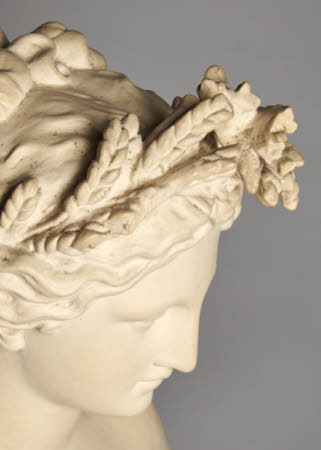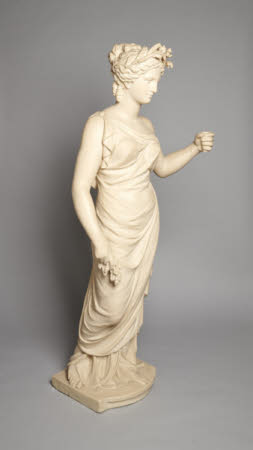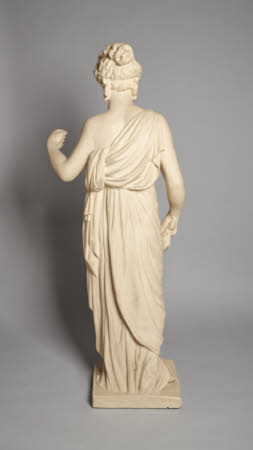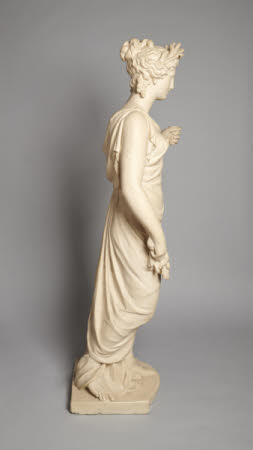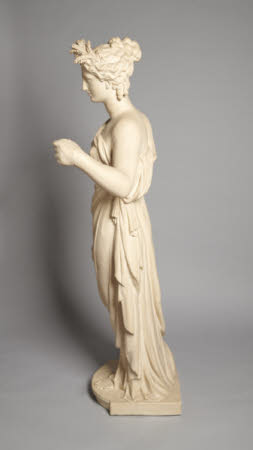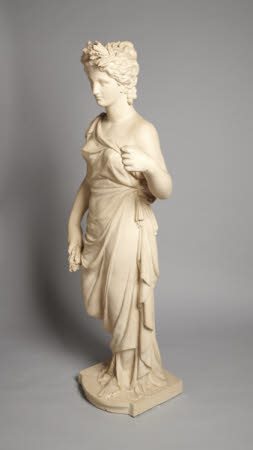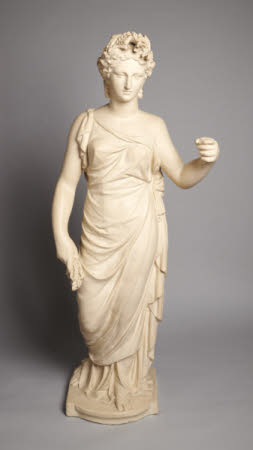Statue of Ceres, goddess of agriculture, a torchère or light-holder
Humphrey Hopper (Wolsingham 1765 - London 1844)
Category
Art / Sculpture
Date
c. 1820 - 1830
Materials
Painted plaster
Measurements
1186 x 494 mm; 494 mm (L)
Place of origin
London
Order this imageCollection
The Argory, County Armagh
NT 565240
Summary
Sculpture, plaster; Statue of Ceres, goddess of agriculture; Humphrey Hopper (1764/65-1844); c. 1810-1830. A plaster statue of Ceres, the Roman goddess of agriculture, by or after Humphrey Hopper. One of a pair of statues, the other depicting Flora, the goddess of Spring. Both were made to carry lights.
Full description
A plaster statue of a standing woman, identifiable as Ceres, the Roman goddess of agriculture, through the tiara formed of heads of corn that she wears in her hair, and the lengths of corn that she has gathered and holds in her right hand. Ceres is dressed in a diaphanous close-fitting robe, fastened at her right shoulder with a brooch and looped behind her left arm, so that her left shoulder is left bare. Her left hand is raised and clenched, with a hole in the centre, designed to hold a lamp, which is now missing. The left hand is broken at the wrist and repaired. On an integral rectangular base, bowed at the front. This figure seems to be loosely based on a famous antique sculpture, the so-called Farnese Flora, now in the Museo Archeologico Nazionale in Naples, but until 1800 one of the principal ancient sculptures to be seen in Rome. The Ceres has a pair, a figure of Flora, Roman goddess of the Spring (NT 565239). They are part of a series of similar sculptures designed by Humphrey Hopper (1765-1844) and made to support metal lights, which would have been held in the figures’ outstretched hands. The two statues at the Argory are both designed so that they lean forward, thereby casting more light out into the spaces they illuminate. Born in County Durham, Hopper is said to have begun his working life as a stonemason who, through his own efforts, was able to rise to the status of professional sculptor. In 1801 he enrolled in the Royal Academy Schools to study sculpture, subsequently winning two student medals. Hopper enjoyed a moderately successful career, making a large number of monuments, as well as a small number of portrait busts. A quite significant part of his work during the first two decades of the nineteenth century consisted in the production of these elegant, if slightly static, statues in plaster, sometimes patinated to give the effect of bronze, and designed to hold lights. A few of the figures are male, but most depict graceful nymphs and goddesses in the classical style. Some of his figures may have been designed by the painter and illustrator Thomas Stothard (1755-1834), by whom there is a drawing of two maidens holding oil lamps (Clifford 1992, p. 47, fig. 7). Hopper was by no means the only sculptor making these sorts of torchere figures; a very similar pair of figures of Comedy and Tragedy signed by Francis Hardenberg (fl. 1783-1832) and dated 1805 is at Heaton Hall, Manchester (Clifford 1992, p. 48, fig. 9). Many of Humphrey Hopper's figures are inscribed with the sculptor’s name and date, reflecting legislation introduced in 1798, sometimes called the Garrard Act after the sculptor George Garrard, which gave sculptors protection for fourteen years over their original designs, provided the work was signed and dated (Clifford 1992, p. 44). The earliest-known date for his plaster figures is 1806, whilst in 1808 Hopper exhibited one at the Royal Academy, a figure of ‘Mercury, intended to support a lamp.’ They must have been commercially successful, given the considerable number that survive, many but not all of which are signed and dated. There is a group of four figures of Bacchus at Lancaster House, three dated 1813 and the other 1818 (Rutherford 1992, p. 135, fig. 88), whilst another group of four was sold from Hackwood House in 1998, all dated 1813, and depicting Bacchus, Hebe, Hygeia and Ceres (Hackwood Park, Christie’s London, 22 April 1998, lot 159). There is a bronzed figure of Venus signed and dated 1 November 1815 at Castle Ward NT 836671), whilst a pair of lustres with figures of Bacchus and Ariadne are signed and dated 24 December 1819 (Clifford 1992, p. 46, fig. 6). The figures of Ceres and Flora appear from time to time in the sale rooms, for example: Flora, dated 1810 (Rowley’s, Newmarket, 20 Feb 2018, lot 195); Ceres and Flora as a pair, dated 1810 (European Sculpture and Works of Art, Sotheby’s London, 9 July 2008, lot 153, black-patinated. Inscribed ‘July 2 1810 H. Hopper London’); Ceres, paired with a figure of Hygeia, dated 1813 (Leland Little, Hillsborough, New Carolina, 11 June 2022, lot 267); Flora and Ceres, signed but undated (Sworders, Mountfichet, 19 Nov. 2013, lot 511); Ceres, undated (Sotheby’s London, 9 July 2008, lot 153). Most of these figures have an identical design of base to the Argory figures, rectangular with a shallow bowed front. Since his dated figures all appear to be within the years 1806-19, it may be that the absence of a signature and date on the Argory figures is an indication that Hopper gave up this practice at some point after 1819. It would be logical for the figures to have been acquired by Walter McGeough Bond in the early 1820s specifically for the Argory, the new house that was being built for him between 1820 and 1824. Jeremy Warren November 2022
Provenance
Probably acquired by Walter McGeough Bond (1790-1866); by descent; Walter McGeough Bond (1908-86), by whom given to the National Trust in 1979.
Makers and roles
Humphrey Hopper (Wolsingham 1765 - London 1844), sculptor
References
Clifford 1992: Timothy Clifford, ‘The Plaster Shops of the Rococo and Neo-classical era in Britain’, Journal of the History of Collections, 4, no. 1 (1992), pp. 39-65., esp. pp. 44-48, pp. 57-58. Rutherford 1992: Jessica Rutherford, Country House Lighting, Leeds 1992., p. 135. Roscoe 2009: I. Roscoe, E. Hardy and M. G. Sullivan, A Biographical Dictionary of Sculptors in Britain 1660-1851, New Haven and Yale 2009, pp. 639-42.
